Parts of a Toilet: What They Are and How to Fix Them
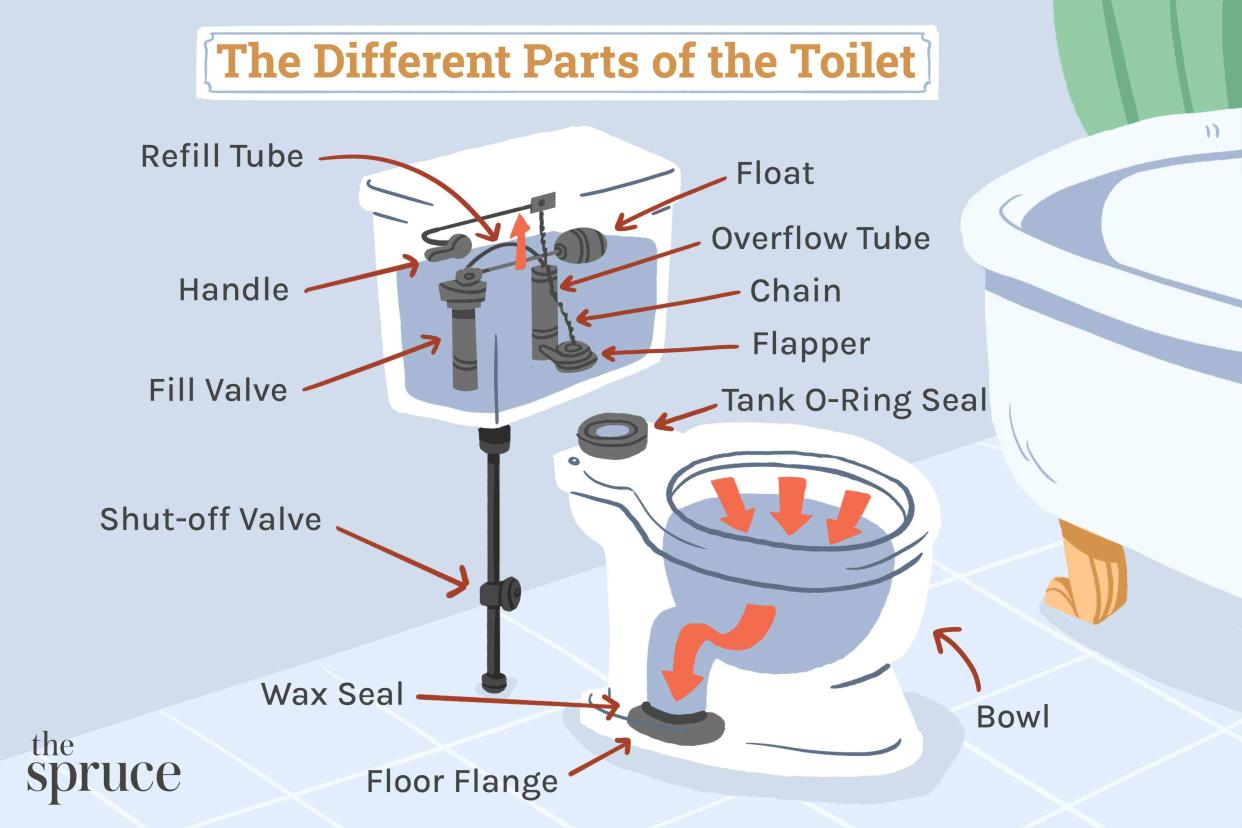
The Spruce / Theresa Chiechi
Reviewed by Richard Epstein
A toilet is such a familiar component of bathrooms that its individual parts are often overlooked. When there is an issue with the toilet, though, it's vital to know the name of each part, where it is located, and what it does before you can fix the problem. Nearly every part of a toilet can be divided between two main sections, the toilet tank and the toilet bowl, with most of the working parts located in the tank.
Parts of a Toilet Tank
The toilet tank is the large container above and behind the toilet bowl that holds water to flush away waste in the bowl. Toilet tanks and toilet bowls are usually two separate parts that are attached upon installation. A one-piece toilet is one where the toilet tank and bowl are integrated as a single unit.
Tip
Whenever working on the inside of the toilet tank, first empty the water. Do so by turning off the water supply valve, located near the floor. Then, flush the toilet.
Toilet Handle
The toilet handle is a lever or set of buttons on the front, side, or top of the toilet tank. Pushing the handle sends stored water from the tank rushing into the towel bowl to carry waste down the sewer.
Problems with the toilet handle are often not related to the handle but to mechanisms in the tank like the toilet chain or flapper. When there is a problem with the toilet handle, it's often because the handle is loose.
To fix a toilet handle, first remove the toilet tank lid. Holding the toilet handle with one hand, use the other hand to rotate the plastic nut inside the tank counter-clockwise (not clockwise) to tighten it.
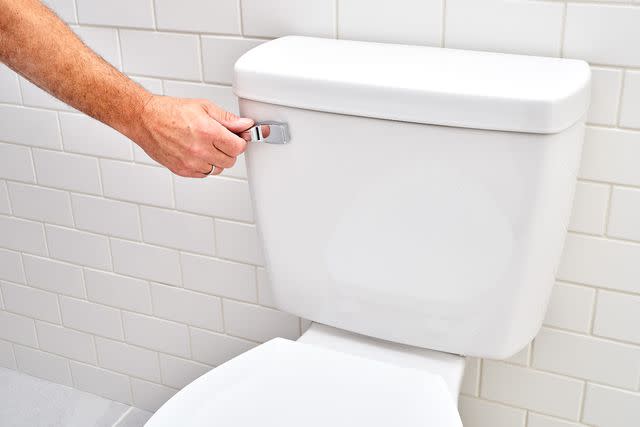
The Spruce / Kevin Norris
Toilet Chain and Lift Wire
The toilet chain and attached lift wire respond to pressure from the toilet handle. They lift the toilet flapper to release water into the toilet bowl.
Both parts are located inside the toilet tank, on the other side of the toilet handle. One end of the metal or plastic lift wire is attached to the back of the toilet handle. The other end of the lift wire is attached to the stainless steel toilet chain. The lift wire acts like a crane arm to raise the toilet chain, thus raising the toilet flapper at the bottom of the tank.
The toilet chain links can become snagged or the chain will detach or break. The lift wire may loosen from the toilet handle.
To fix a toilet chain and lift wire, first try unsnagging the chain links if the chain is still attached. Otherwise, remove the lift wire from the handle by turning the plastic nut clockwise (not counter-clockwise). Remove the end of the toilet chain from the flapper, then replace in reverse with the new toilet chain and lift wire.
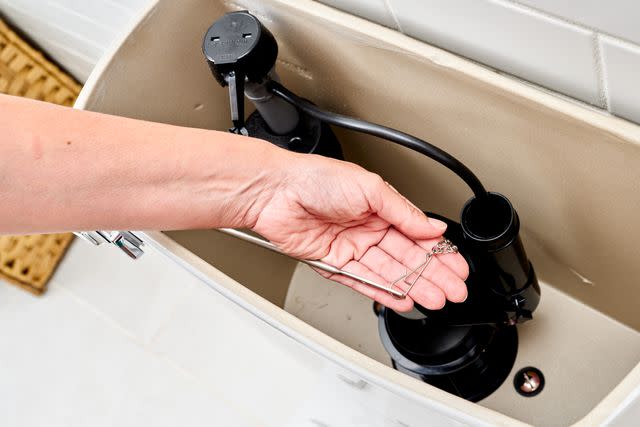
The Spruce / Kevin Norris
Toilet Flapper or Flap Valve
The toilet flapper is the hinged flexible rubber valve that opens to permit water from the toilet tank to rush into the toilet bowl. The toilet flapper covers the outlet at the bottom of the tank.
When a toilet makes a hissing sound, one reason is that the toilet flapper has hardened and lost its seal after enough time. Purchase a new 2-inch toilet flapper to replace most flappers.
To replace a toilet flapper, start by emptying the toilet tank of water, then dry the bottom of the tank with a towel. Unhook the flapper from the toilet chain and remove the flapper from the fill tube by unhooking its two ears. Hook the new flapper to the bottom of the fill tube, then attach the toilet chain, then turn the water on again.
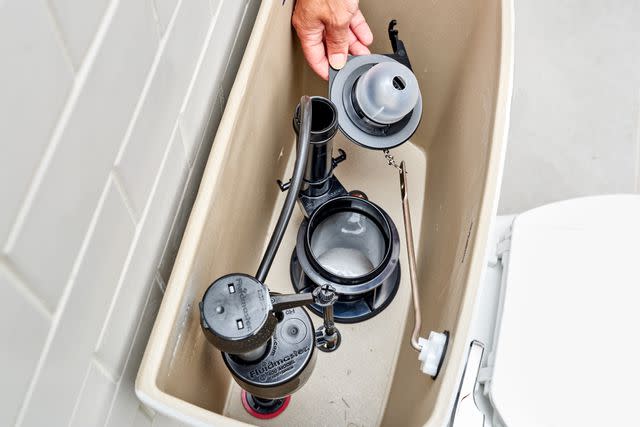
The Spruce / Kevin Norris
Toilet Fill Valve
The toilet fill valve is a vertical plastic tube that helps bring water into the toilet tank, The fill valve also senses when the water level in the tank is at its proper height. The fill tube is located in the toilet tank off-center and directly over the point where the water supply enters the tank.
Toilet fill valves replace the older toilet float or ballcock (a buoyant ball on a lever).
Plastic fill tubes may crack and leak over time. The best solution is to purchase a replacement fill tube and install it in place of the faulty fill tube.
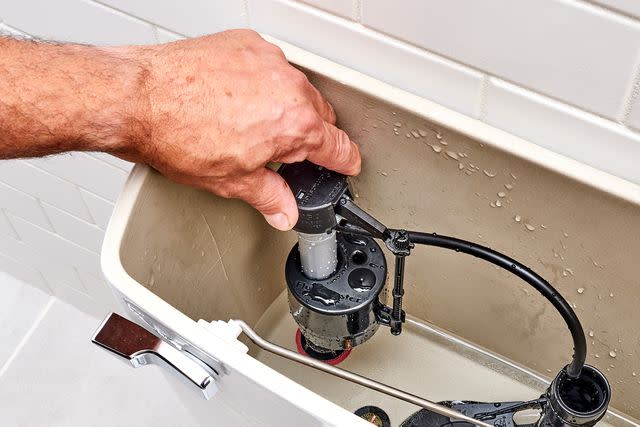
The Spruce / Kevin Norris
Toilet Float or Ballcock
The toilet float is a round plastic or aluminum ball that is buoyant enough to float on top of the water in the toilet tank. The toilet float is responsible for managing the level of water in the toilet tank.
Toilet floats are generally not found on newer toilets, which use a refill valve instead.
When the toilet float no longer floats on the tank water, the best solution is to install a new float. Symptoms that point to the need for a new toilet float: water flowing after the tank is full; tank not filling completely; or the toilet continually running.
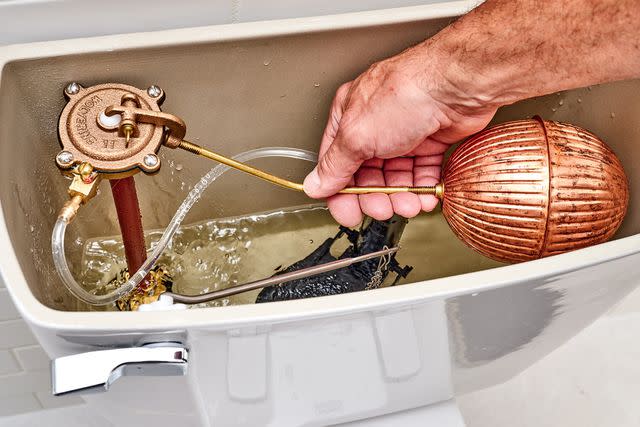
The Spruce / Kevin Norris
Toilet Overflow Tube
The toilet overflow tube, or flush valve, is a vertical plastic tube in the toilet tank. The overflow tube moves water from the tank to the toilet bowl to prevent water in the tank from overflowing. The overflow tube is also required to fill the bowl to the proper level for the next flush.
Tip
Though it's easy to confuse the overflow tube with the fill valve, the overflow tube can be identified because it has the flapper valve at the bottom and because it has no sliding floatation device.
To replace a toilet overflow tube, start by turning off the water and emptying the water from the tank. From underneath the toilet tank, remove the bolts and washers. Remove the tank and remove the old overflow or flush valve and gasket. Clean and dry the bottom of the tank, then install the new overflow tube from inside the top of the tank. Install the new gasket on the hole on top of the toilet bowl. Set the tank back in place and bolt it, then turn on the water.
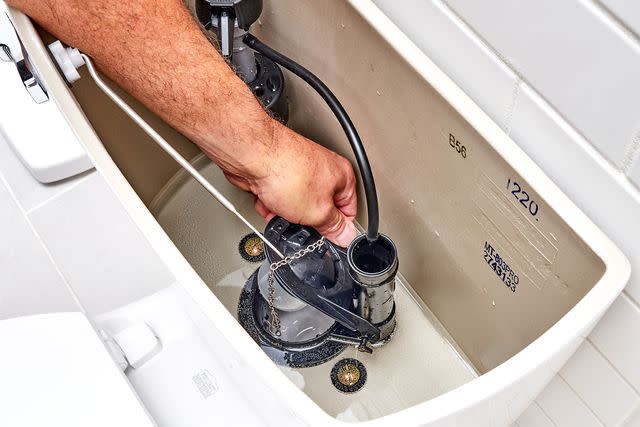
The Spruce / Kevin Norris
Toilet Water Supply Line and Valve
The water supply (shut-off) valve is an oblong-shaped faucet handle on the pipe that supplies the toilet with fresh water. Water runs through the flexible short braided metal or polymer 3/8-inch from the valve to the toilet.
The supply valve is located at the end of a pipe extending from the wall, a few inches above the floor. The water supply line starts at this valve and ends at the bottom of the toilet tank.
Shut-off valves' plastic handles are prone to breakage if turned too tightly. Shut-off valves can be removed and inexpensively replaced. The same braided water supply line can be reused if it is still in good condition.

The Spruce / Kevin Norris
Parts of a Toilet Bowl
Toilet Bowl
The toilet bowl is the large, lower base that removes the waste, plus it's where the user sits. Most bowls are made of vitreous china, a waterproof material that resists staining well. An internal trap holds fresh water to seal against sewer gasses entering the bathroom.
As a solid piece with no moving parts, the toilet bowl itself rarely malfunctions. Over-tightening the T-bolts at the base or the tank bolts may crack the porcelain. To clear a clogged toilet, use a toilet plunger to force the clog away. If that doesn't work, use a toilet snake (or auger) to grab onto the clog and extract it.
Tip
Use a bell-shaped toilet plunger with a fold-out flap at the end. An open-end bell-shaped plunger is for sinks, but you can try using it on toilets if a toilet plunger is not available.
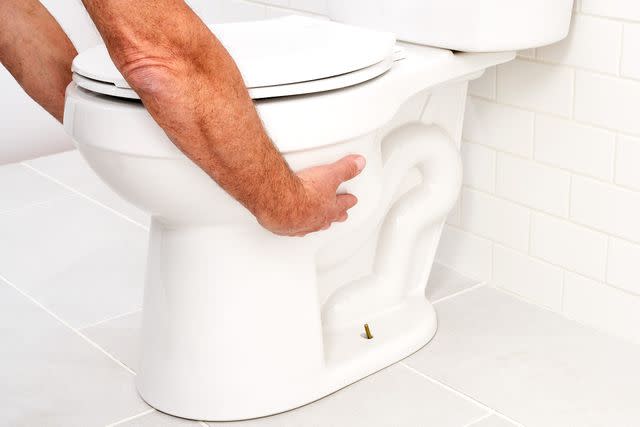
The Spruce / Kevin Norris
Toilet Tank O-Ring Seal
The toilet tank O-ring seal (also called a tank-to-bowl or mack washer) is a round rubber gasket that prevents water from leaking from the bottom of the toilet tank. The O-ring seal is located between the bottom of the toilet tank and the top of the toilet bowl.
When a toilet is leaking between the tank and the top of the bowl, the reason is usually a poorly installed or cracked O-ring seal.
To fix a toilet tank O-ring seal, shut off the water supply and empty the tank. Remove the water supply tube and let its water drain into a container. Underneath the back of the toilet tank and bowl rim, locate the two tank nuts; they may be either metal or plastic. With metal nuts, use a socket wrench underneath to turn out the nuts and remove them. For plastic nuts, turn them out by hand. First remove the tank lid, then lift the tank off of the toilet bowl. Remove the old O-ring seal and clean the area with a soft cloth. Insert the new O-ring seal, cone side pointed down. Reverse the steps to replace the tank.
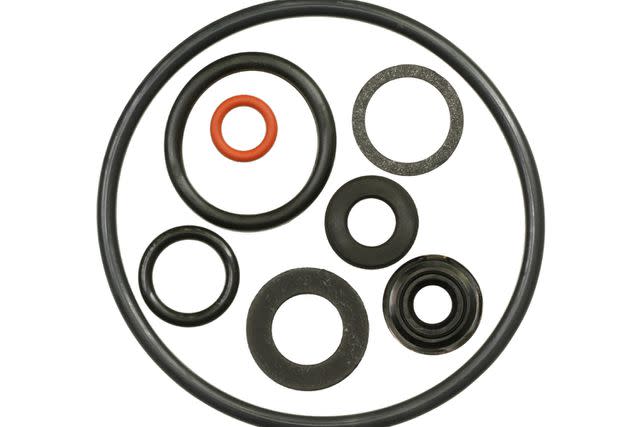
Getty Images
Toilet Wax or Silicone Seal
The toilet wax seal is a round, cone-shaped collapsible gasket that prevents water from leaking from the bottom of the toilet bowl. The toilet wax seal is located between the bottom of the toilet bowl and the floor flange. Sometimes, this seal is a donut-shaped part made from silicone.
When the toilet is leaking from its base, the wax seal may be dried out, cracked, or too small for the space.
To fix a toilet wax seal, first remove the toilet, then scrape off the old wax ring and dispose of it. Continue to clean off all remnants of the old wax seal thoroughly, then remove the plastic covering from the new wax seal. Press the wax seal on the bottom of the toilet with the plastic cone pointing down. Press the seal hard enough to make it stick but do not compress it. Set the toilet down in a smooth, continuous motion. Make sure that the T-bolts are in place and that they protrude through the holes in the toilet bowl base. Wax seals can only be used once. If you need to reposition a toilet after it has been set down, use a new seal.
Tip
Extra-thick wax rings can help provide a tighter seal when there are height issues. But first try to fix any spacing problems with toilet flange extenders instead of thicker wax rings.

The Spruce / Kevin Norris
Toilet Floor Flange
The toilet floor flange or closet flange is a round plastic or metal bracket that holds the toilet to the floor with screws and bolts.
The flange is located between the floor and the bottom of the toilet bowl. The flange is attached to the floor with screws, and the toilet is attached to the flange with T-bolts.
Due to movement and the presence of water, floor flanges and their fasteners can rust and break. This may cause the toilet to leak around the bottom.
To fix a toilet floor flange, first turn off the water and empty the tank, then remove the toilet from the floor. Move the toilet away. Unscrew the old flange and scrape off the wax ring and clean thoroughly. Screw the new floor flange directly to the floor. Slide the new T-bolts into the flange with the threads pointing up. Add the washers to hole the T-bolts in place. Replace the toilet.
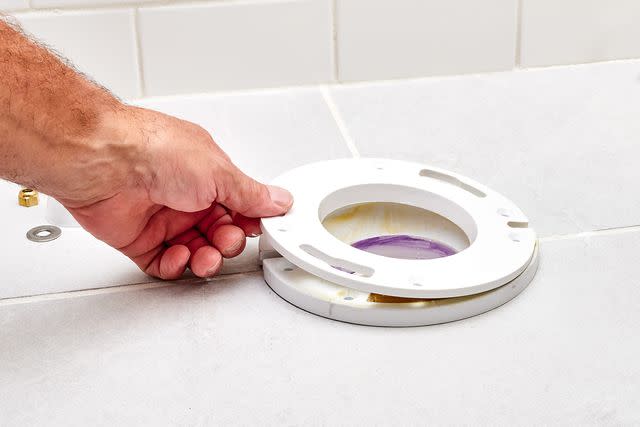
The Spruce / Kevin Norris
Tip
If the flange is not flush (even) with the floor surface, install a toilet flange extender.
Frequently Asked Questions
What are the parts in the toilet tank?
The two main parts of the toilet are the tank at top and the bowl at bottom. In the toilet tank is the fill tube, the overflow tube, a chain, and a flapper. Older toilets have a floating ballcock. Key parts of the toilet bowl: O-ring seal, wax or silicone seal, and floor flange.
What is the upper part of a toilet called?
The upper part of a toilet is called the tank. The tank is a reservoir that holds water to flush away waste in the toilet bowl.
What is the thing that flushes the toilet called?
The device inside the toilet tank that flushes the toilet is called a toilet flapper or flapper valve. The toilet flapper is raised by depressing the toilet handle.
Read the original article on The Spruce.

